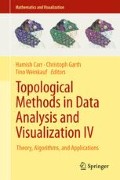Abstract
Lagrangian coherent structures provide insight into unsteady fluid flow, but their construction has posed many challenges. These structures can be characterized as ridges of a field, but their local definition utilizes an ambiguous eigenvector direction that can point in one of two directions, and its ambiguity can lead to noise and other problems. We overcome these issues with an application of a global ridge definition, applied using the hierarchical watershed transformation. We show results on a mathematical flow model and a simulated vascular flow dataset indicating the watershed method produces less noisy structures.
Access this chapter
Tax calculation will be finalised at checkout
Purchases are for personal use only
Notes
- 1.
The term watershed comes from hydrology, where it denotes a drainage basin region. Some texts that apply it to dataset analysis incorrectly use it to refer to the ridges separating these basins, and call the basins “catchment basins.” To avoid confusion, we will refer to ridges that separate regions.
References
Beucher, S.: Watershed, hierarchical segmentation and waterfall algorithm. In: Mathematical Morphology and Its Applications to Image Processing, Computational Imaging and Vision, vol. 2, pp. 69–76. Springer, New York (1994)
Eberly, D.: Ridges in Image and Data Analysis. Kluwer Academic Publishers, Dordrecht (1996)
Edelsbrunner, H., Harer, J.: Persistent homology — a survey. In: Surveys on Discrete and Computational Geometry, Contemporary Mathematics, vol. 453, pp. 257–282. American Mathematical Society, Providence (2006)
Furst, J.D., Pizer, S.M.: Marching ridges. In: SIP, pp. 22–26 (2001)
Haller, G.: Distinguished material surfaces and coherent structures in three-dimensional fluid flows. Physica D 149(4), 248–277 (2001)
Haller, G.: A variational theory of hyperbolic Lagrangian coherent structures. Physica D 240(7), 574–598 (2011)
Hege, H.C., Stalling, D., Seebass, M., Zöckler, M.: A generalized marching cubes algorithm based on non-binary classifications. Technical Report SC-97-05, Konrad-Zuse-Zentrum (ZIB) (1997)
Hucko, M., Sramek, M.: Interactive segmentation of volume data using watershed hierarchies. Winter School Comput. Graph. 20(3), 217–222 (2012)
Lindeberg, T.: Feature detection with automatic scale selection. Int. J. Comput. Vis. 30(2), 79–116 (1998)
Lorensen, W.E., Cline, H.E.: Marching cubes: a high resolution 3D surface construction algorithm. Proc. SIGGRAPH 21(4), 163–169 (1987)
Peacock, T., Haller, G.: Lagrangian coherent structures: the hidden skeleton of fluid flows. Phys. Today 66(2), 41 (2013)
Peikert, R., Sadlo, F.: Height ridge computation and filtering for visualization. In: IEEE Pacific Visualization Symposium, pp. 119–126. IEEE, New York (2008)
Reitinger, B., Bornik, A., Beichel, R.: Consistent mesh generation for non-binary medical datasets. In: Bildverarbeitung für die Medizin, pp. 183–187. Springer, New York (2005)
Roerdink, J.B., Meijster, A.: The watershed transform: definitions, algorithms and parallelization strategies. Fundam. Inf. 41(1), 187–228 (2000)
Sadlo, F., Peikert, R.: Efficient visualization of lagrangian coherent structures by filtered AMR ridge extraction. IEEE Trans. Vis. Comput. Graph. 13(6), 1456–1463 (2007)
Sahner, J., Weinkauf, T., Teuber, N., Hege, H.C.: Vortex and strain skeletons in Eulerian and Lagrangian frames. IEEE Trans. Vis. Comput. Graph. 13(5), 980–990 (2007)
Schindler, B., Fuchs, R., Barp, S., Waser, J., Pobitzer, A., Carnecky, R., Matkovic, K., Peikert, R.: Lagrangian coherent structures for design analysis of revolving doors. IEEE Trans. Vis. Comput. Graph. 18(12), 2159–2168 (2012)
Schindler, B., Peikert, R., Fuchs, R., Theisel, H.: Ridge concepts for the visualization of Lagrangian coherent structures. In: Topological Methods in Data Analysis and Visualization II, pp. 221–235. Springer, Berlin (2012)
Schultz, T., Theisel, H., Seidel, H.P.: Crease surfaces: from theory to extraction and application to diffusion tensor MRI. IEEE Trans. Vis. Comput. Graph. 16(1), 109–119 (2010)
Shadden, S.C.: Lagrangian coherent structures. In: R. Grigoriev (ed.) Transport and Mixing in Laminar Flows: From Microfluidics to Oceanic Currents, Chap. 3, pp. 59–89. Wiley, Weinheim (2012)
Shadden, S.C., Lekien, F., Marsden, J.E.: Definition and properties of Lagrangian coherent structures from finite-time Lyapunov exponents in two-dimensional aperiodic flows. Physica D 212(3-4), 271–304 (2005)
Vincent, L., Soille, P.: Watersheds in digital spaces: an efficient algorithm based on immersion simulations. IEEE Trans. Pattern Anal. Mach. Intell. 13(6), 583–598 (1991)
Wu, Z., Sullivan, J.: Multiple material marching cubes algorithm. Int. J. Numer. Methods Eng. 58(2), 189–207 (2003)
Acknowledgements
This work was supported in part by NSF Grants OCI-1047963 and OCI-1047764. We thank Siavash Ameli for his help with this project.
Author information
Authors and Affiliations
Corresponding author
Editor information
Editors and Affiliations
Rights and permissions
Copyright information
© 2017 Springer International Publishing AG
About this paper
Cite this paper
Chen, M., Hart, J.C., Shadden, S.C. (2017). Hierarchical Watershed Ridges for Visualizing Lagrangian Coherent Structures. In: Carr, H., Garth, C., Weinkauf, T. (eds) Topological Methods in Data Analysis and Visualization IV. TopoInVis 2015. Mathematics and Visualization. Springer, Cham. https://doi.org/10.1007/978-3-319-44684-4_14
Download citation
DOI: https://doi.org/10.1007/978-3-319-44684-4_14
Published:
Publisher Name: Springer, Cham
Print ISBN: 978-3-319-44682-0
Online ISBN: 978-3-319-44684-4
eBook Packages: Mathematics and StatisticsMathematics and Statistics (R0)

